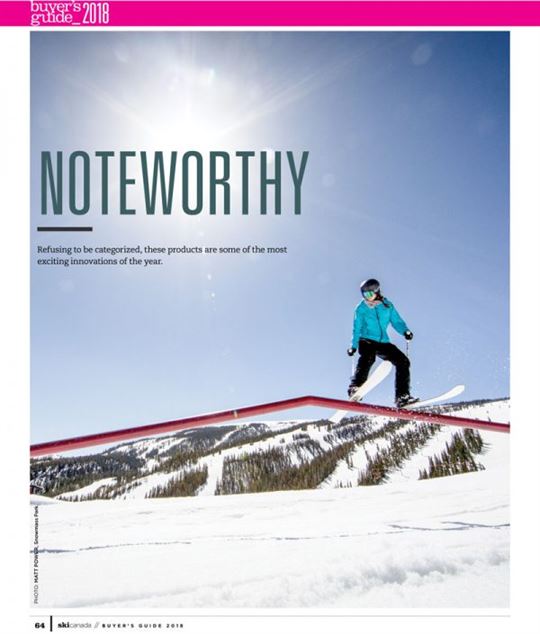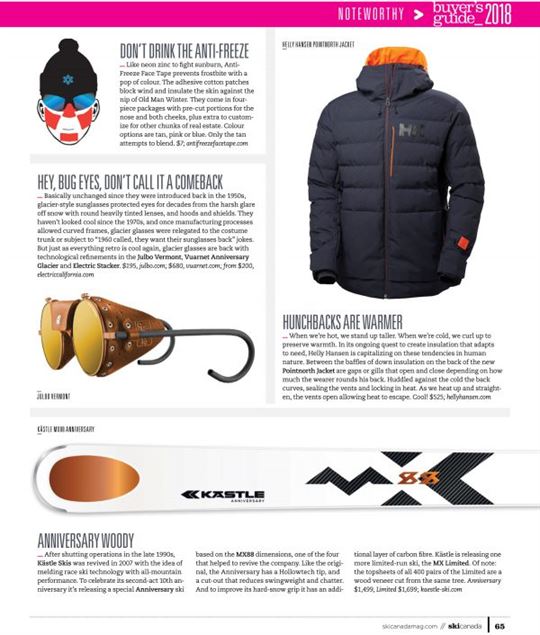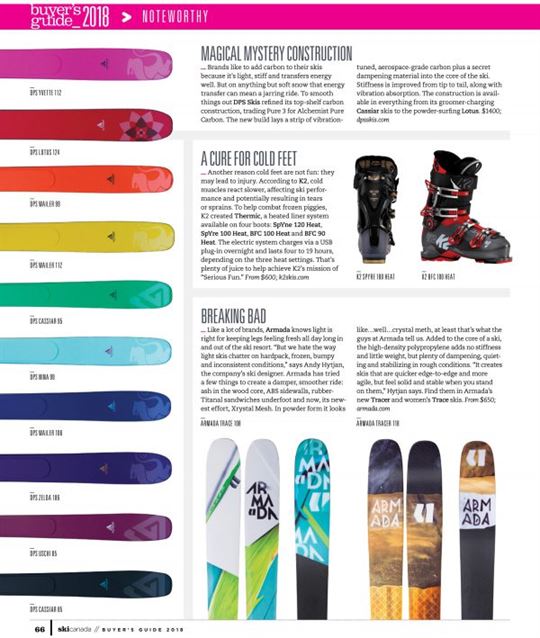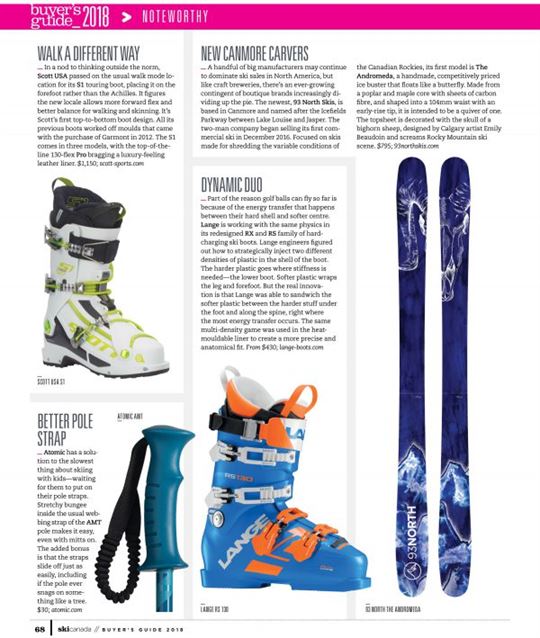Refusing to be categorized, these products are some of the most exciting innovations of the year.

DON’T DRINK THE ANTI-FREEZE
Like neon zinc to fight sunburn, Anti-Freeze Face Tape prevents frostbite with a pop of colour. The adhesive cotton patches block wind and insulate the skin against the nip of Old Man Winter. They come in four-piece packages with pre-cut portions for the nose and both cheeks, plus extra to customize for other chunks of real estate. Colour options are tan, pink or blue. Only the tan attempts to blend. $7; antifreezefacetape.com
HEY, BUG EYES, DON’T CALL IT A COMEBACK
Basically unchanged since they were introduced back in the 1950s, glacier-style sunglasses protected eyes for decades from the harsh glare off snow with round heavily tinted lenses, and hoods and shields. They haven’t looked cool since the 1970s, and once manufacturing processes allowed curved frames, glacier glasses were relegated to the costume trunk or subject to “1960 called, they want their sunglasses back” jokes. But just as everything retro is cool again, glacier glasses are back with technological refinements in the Julbo Vermont, Vuarnet Anniversary Glacier and Electric Stacker. $195, julbo.com; $680, vuarnet.com; from $200, electriccalifornia.com
HUNCHBACKS ARE WARMER
When we’re hot, we stand up taller. When we’re cold, we curl up to preserve warmth. In its ongoing quest to create insulation that adapts to need, Helly Hansen is capitalizing on these tendencies in human nature. Between the baffles of down insulation on the back of the new Pointnorth Jacket are gaps or gills that open and close depending on how much the wearer rounds his back. Huddled against the cold the back curves, sealing the vents and locking in heat. As we heat up and straighten, the vents open allowing heat to escape. Cool! $525; hellyhansen.com
ANNIVERSARY WOODY
After shutting operations in the late 1990s, Kästle Skis was revived in 2007 with the idea of melding race ski technology with all-mountain performance. To celebrate its second-act 10th anniversary it’s releasing a special Anniversary ski based on the MX88 dimensions, one of the four that helped to revive the company. Like the original, the Anniversary has a Hollowtech tip, and a cut-out that reduces swingweight and chatter. And to improve its hard-snow grip it has an additional layer of carbon fibre. Kästle is releasing one more limited-run ski, the MX Limited. Of note: the topsheets of all 400 pairs of the Limited are a wood veneer cut from the same tree. Anniversary $1,499, Limited $1,699; kaestle-ski.com
MAGICAL MYSTERY CONSTRUCTION
Brands like to add carbon to their skis because it’s light, stiff and transfers energy well. But on anything but soft snow that energy transfer can mean a jarring ride. To smooth things out DPS Skis refined its top-shelf carbon construction, trading Pure 3 for Alchemist Pure Carbon. The new build lays a strip of vibration-tuned, aerospace-grade carbon plus a secret dampening material into the core of the ski. Stiffness is improved from tip to tail, along with vibration absorption. The construction is available in everything from its groomer-charging Cassiar skis to the powder-surfing Lotus. $1400; dpsskis.com
A CURE FOR COLD FEET
Another reason cold feet are not fun: they may lead to injury. According to K2, cold muscles react slower, affecting ski performance and potentially resulting in tears or sprains. To help combat frozen piggies, K2 created Thermic, a heated liner system available on four boots: SpYne 120 Heat, SpYre 100 Heat, BFC 100 Heat and BFC 90 Heat. The electric system charges via a USB plug-in overnight and lasts four to 19 hours, depending on the three heat settings. That’s plenty of juice to help achieve K2’s mission of “Serious Fun.” From $600; k2skis.com
BREAKING BAD
Like a lot of brands, Armada knows light is right for keeping legs feeling fresh all day long in and out of the ski resort. “But we hate the way light skis chatter on hardpack, frozen, bumpy and inconsistent conditions,” says Andy Hytjan, the company’s ski designer. Armada has tried a few things to create a damper, smoother ride: ash in the wood core, ABS sidewalls, rubber-Titanal sandwiches underfoot and now, its newest effort, Xrystal Mesh. In powder form it looks like…well…crystal meth, at least that’s what the guys at Armada tell us. Added to the core of a ski, the high-density polypropylene adds no stiffness and little weight, but plenty of dampening, quieting and stabilizing in rough conditions. “It creates skis that are quicker edge-to-edge and more agile, but feel solid and stable when you stand on them,” Hytjan says. Find them in Armada’s new Tracer and women’s Trace skis. From $650; armada.com
WALK A DIFFERENT WAY
In a nod to thinking outside the norm, Scott USA passed on the usual walk mode location for its S1 touring boot, placing it on the forefoot rather than the Achilles. It figures the new locale allows more forward flex and better balance for walking and skinning. It’s Scott’s first top-to-bottom boot design. All its previous boots worked off moulds that came with the purchase of Garmont in 2012. The S1 comes in three models, with the top-of-the-line 130-flex Pro bragging a luxury-feeling leather liner. $1,150; scott-sports.com
NEW CANMORE CARVERS
A handful of big manufacturers may continue to dominate ski sales in North America, but like craft breweries, there’s an ever-growing contingent of boutique brands increasingly dividing up the pie. The newest, 93 North Skis, is based in Canmore and named after the Icefields Parkway between Lake Louise and Jasper. The two-man company began selling its first commercial ski in December 2016. Focused on skis made for shredding the variable conditions of the Canadian Rockies, its first model is The Andromeda, a handmade, competitively priced ice buster that floats like a butterfly. Made from a poplar and maple core with sheets of carbon fibre, and shaped into a 104mm waist with an early-rise tip, it is intended to be a quiver of one. The topsheet is decorated with the skull of a bighorn sheep, designed by Calgary artist Emily Beaudoin and screams Rocky Mountain ski scene. $795; 93northskis.com
DYNAMIC DUO
Part of the reason golf balls can fly so far is because of the energy transfer that happens between their hard shell and softer centre. Lange is working with the same physics in its redesigned RX and RS family of hard-charging ski boots. Lange engineers figured out how to strategically inject two different densities of plastic in the shell of the boot. The harder plastic goes where stiffness is needed—the lower boot. Softer plastic wraps the leg and forefoot. But the real innovation is that Lange was able to sandwich the softer plastic between the harder stuff under the foot and along the spine, right where the most energy transfer occurs. The same multi-density game was used in the heat-mouldable liner to create a more precise and anatomical fit. From $430; lange-boots.com
BETTER POLE STRAP
Atomic has a solution to the slowest thing about skiing with kids—waiting for them to put on their pole straps. Stretchy bungee inside the usual webbing strap of the AMT pole makes it easy, even with mitts on. The added bonus is that the straps slide off just as easily, including if the pole ever snags on something like a tree. $30; atomic.com






